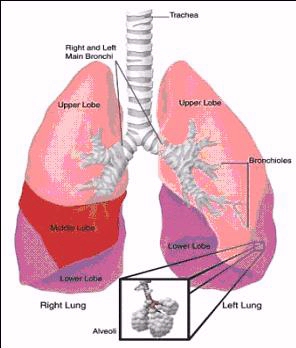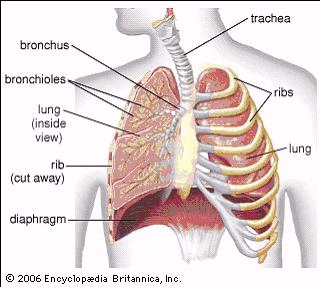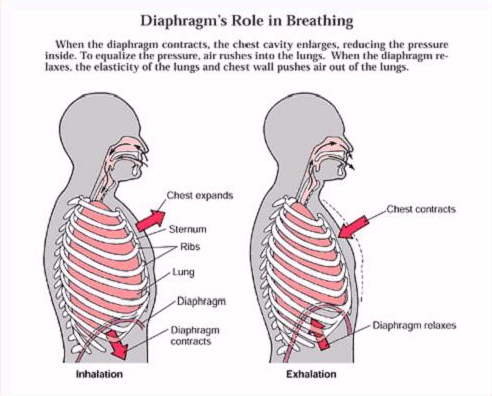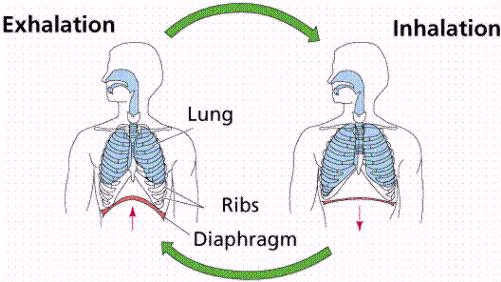
Figure 1. The lungs in cross section
On a recent surf of the internet, I came across some amusing comments about cellists and their breathing from a radio listener: "I always find that 'cello players breathe loudly, even on recordings! I wondered if perhaps it is a symptom of having to lean over the front of the 'cello to bow." Our public notices (perhaps more than we know) a habit that is overlooked by many of us. What Alexander called a conspicuous defect is all too common amongst students and professionals.
The verbs 'to breathe' and 'to inspire' have the same Latin root: inspirare. The various meanings of the verb 'to inspire' are associated with the intake of a vital sustaining power or emotion:
The question to ask here is this: how can we move without straining for breath? We have a force to contend with -- the downward force of gravity. How do we learn to play up against this force, to use it according to what Alexander called the principle of mechanical advantage. What idea of a 'correct position' can compare with a dynamic equilibrium which permits us moment to moment changes as we shift our weight, breathing freely to do so? The true principles of equilibrium are simple but not easy to put into practice, as they contravene our habits.
What do you first think of when asked to 'take a breath'? Chances are the process is automatic; you prepare to inhale by a series of unconscious movements and unthinkingly draw in air as best you know how. Or if you have practiced deep breathing exercises, you have your routine of inhaling and exhaling according to which version you have learned. In either case, your idea is to get the breath into the body and out again. You may do this by raising the chest, pushing in the lower back, lifting the abdomen, pulling the neck and head forward -- the variations are many and all are harmful over time. The idea that breathing is an activity of the whole body (all its parts in relation to the whole), including the attention, might not have crossed your mind. You might not think of stopping first to let go of the air you have before waiting for the breath to come in.
The Alexander Technique posits a radically different approach to breathing. Working with the Alexander principle, 'Use affects Functioning' at its most elemental level, this principle shows us that the way we use ourselves generally affects our breathing function in particular. Alexander did not teach breathing exercises, believing the practice of them to be harmful for the following reason: the practitioner of such exercises is going after a specific end in mind without taking into account the general conditions present. "All exercises that involve deep breathing cause an exaggeration of the defective muscular coordination already present." 1 If the ribs of our thoracic (chest) cavity are held and if there is tension present in the surrounding muscular structures (and that includes even the legs and feet, and especially the buttocks!), breathing exercises merely cultivate more of the same, reinforcing the existing tensions. More energy is employed to squeeze the air out and drag it into the lungs in an effort to overcome the restrictions.
The mechanics of breathing involve related sets of muscles and, of course, the lungs--large, lobed, paired organs in the chest (also known as the thoracic cavity). Thin sheets of epithelium (pleura) separate the inside of the chest cavity from the outer surface of the lungs. The bottom of the thoracic cavity is formed by the diaphragm.
When you inhale, muscles in the chest wall contract, expanding the ribs and lifting them slightly outwards. The diaphragm at this time moves downward, enlarging the chest cavity. Abdominal muscles are also engaged. Reduced air pressure in the lungs from the previous exhalation creates a vacuum which causes air to enter into the lungs. The expanding ribs and widening back make room for the lungs to fill with air. During expiration, the inspiration muscles relax, forcing gases to flow out of the lungs and the cycle repeats.
This all-important sequence is compromised when the player is pulling down onto the cello with the entire force of the upper body, as is common today. In my experience the re-education of the breath should take place away from the instrument -- if the faulty habits are to be fully unlearned. The stimulus of the cello pressing against the chest, as it tends to do when the breathing pattern is defective, prevents one from letting go.
Below are illustrations of the breathing apparatus.

Figure 1. The lungs in cross section

Figure 2. The lobes of the lungs. The lungs are not equal in size. The left lung is smaller because of the space taken up by the heart.

Figure 3. The lungs and ribs. The ribs are the skeletal protection for the lungs and the chest cavity.
The ribs and rib muscles (intercostals) expand and contract with normal breathing.
It is remarkable how high the lungs are situated in the chest cavity; they extrude the top rib. .


Alexander described breathing as an activity of the back. What needs to be 'unlearned' is the pattern of tension which prevents the free flow of air in and out of the lungs. Once the Primary Control (Alexander's term for the neck-head-back relationship) is not interfered with -- neck and jaw freeing, head releasing up of the spine, allowing the spine to lengthen and the back to widen, the pelvis and hips releasing in proper relation to the lengthening spine, the breath will flow freely and be in ample supply relative to the energy needed.
Let's take a look in more detail at Alexander's writings on the breath. Known in his early years as the 'breathing doctor', he first made his reputation working with actors, correcting defects of breathing and speech, one of the most obvious being the gasp for air just before speaking, as audible throughout the theatre as our 'noisy cellists' heavy breathing in the concert hall. What is a gasp and where does it come from? It is the forcible intake of air caused by structures that tighten and close when they should be releasing and opening, beginning with the neck, as Alexander discovered when solving his own problem in this regard.
In his initial observations of himself, when preparing to speak, he discovered three distinct habits -- pulling his head back and down, depressing the larynx, and gasping for breath. Which habit caused which, he asked himself. Only by patient experimentation did he conclude that his pulling back of the head, initiated by tension in the neck, caused the problems with his breath and larynx.
We cellists have the easiest sitting posture of any of the stringed instruments, especially compared with violinists. Yet we manage to contort our heads and necks, pushing them forward or pulling them back, causing the air passages to be contracted. The result is either a tightening or a collapse throughout the chest region.
Therefore, the first habit which interferes immediately with the breath is tension in the neck. You can tighten your neck muscles and experience the result immediately and unequivocally. An easy breath is impossible. The greater the tension, the greater the impediment to free breathing. Some other parts of you will have to overwork to make up for the lack of freedom in the chest and ribs caused by the weight of the head pulling into the spine.
Why do we tense the neck? Perhaps a rhetorical question, but in fact the neck is a sensitive area of the body, full of intersections of nerve and muscle which are related to the fear response. When we are afraid, we tighten the neck reflexively and hold our breath�what is called the 'startle reflex'. We hold onto ourselves -- literally. Another cause is the ubiquitous idea that more effort makes for greater success. The intensity and determination of a Western-trained conservatoire student can be fearsome. The tension engendered by the drive and will to succeed brings to mind the saying of one well-known Alexander teacher: our intentions produce our tensions.
Perhaps in our early learning, as we grasped the unfamiliar instrument and tried to play, a poor habit was born. Or we copied our teachers who had unproductive habits of their own. Maybe as we grew, an adjustment was not made to our instrument or the tension crept in as the difficulty of the repertoire increased. There are a hundred reasons, but underneath them all lies the fact that we are not conscious of what we do or how we interfere. Diminished breathing is the price we pay for not being aware of these habits of tension. Learning to let go in the neck is a long process of relinquishing our ideas of what we should, must, and want to do. The reward comes of itself and by itself�one breath after another.
"If one wishes to correct a pupil's errors in breathing, the first thing to do is to tell him not to breathe, simply because his mental conception of breathing is sucking in air -- it is his habit of life. Tell him, therefore, not to breathe, but enable him to obtain those mechanical advantages which give atmospheric pressure its opportunity�i.e. such relaxation of certain parts, tensing the muscles of others, and ordering the head upwards as will cause the spine to assume a more normal position. He will then breathe as perfectly as his condition permits, and as that condition improves, his breathing will improve correspondingly." 2
What does Alexander mean by mechanical advantage? One of his great discoveries was the principle that governs balanced movement -- antagonistic action. The weight of our head as it balances upon the spine is opposed by the back staying back; the hips oppose the knees which go forward in space as we move. The weight of the body is taken through the feet, the heels of which are well-grounded, in opposition to the upward flow of energies along the spine. Like the roots of a tree which grow downward into the ground as the crown expands upward towards the heavens, we maintain our balance through this principle of opposition, at rest and in movement.
The condition of balance promotes good breathing, giving atmospheric pressure its opportunity for breath to enter and depart effortlessly. I have watched great artists of the past (with excellent use) release thunderous sounds without any huffing and puffing and blowing their scores off the music stand. But it is rare to find such examples of ease on the concert platform these days.
Faulty breathing patterns have a fatal influence on the use of the arms. Inhaling by raising the front of the chest hollows the back and tightens what Alexander called the 'lifter muscles', those very muscles we need to raise and move the arms freely. The breath as an animating force makes the arms and fingers light, easy, and quick on the draw. Distances are covered without any extra effort, and the coordination between the hands is improved.
One of Alexander's aphorisms, "I see at last that if I don't breathe, I breathe� " had me stumped during my teacher training course; like a Zen koan, it requires a suspension of belief in order that the answer may surface of its own accord. When at last I had the experience of letting go of the breath, I understood the deeper meaning of his words. The beginning of the breathing cycle is not taking in but letting go, just the reverse of my conception. To be quiet and to allow the breath to enter goes against the habitual feeling of wanting to take a breath. The sense of calm and order that an efficient breathing mechanism provides is beyond description. The brain and body are nourished by air and there arises a feeling of completeness, a sense of having what is necessary to do the work and play of living.
I would like to conclude with a statement of Alexander's from his 1907 treatise entitled "The Theory and Practice of a New Method of Respiratory Re-Education": "As the breathing mechanism is ordinarily unconsciously controlled, it is necessary, in order to regain full efficiency in the use of it, to proceed by way of conscious control, until the normal conditions return. Afterwards, when perfected, unconscious control, such as originally existed prior to respiratory and physical deterioration, will supervene." 3 To relearn what is natural takes time and patience, but the effort restores the most basic need we have as musicians -- the 'fuel' for our work. But by far the most noticeable difference is in the music-making. A player who breathes well has the possibility of capturing the listener inside the beauty of the music, giving an 'inspired' performance.
1. Why �Deep Breathing� and Physical Culture Exercises do more Harm than Good, July 1908� from Articles and Lectures. F. Matthias Alexander. Mouritz: London, 1995. p. 73.
Selma Gokcen resides in London where she teaches cello and the Alexander Technique at the Guildhall School of Music and Drama. For further information, please contact:
info@welltemperedmusician.com
www.welltemperedmusician.com

| Direct correspondence to the appropriate ICS
Staff Webmaster: Eric Hoffman Director: John Michel Copyright © 1995- Internet Cello Society |
|---|